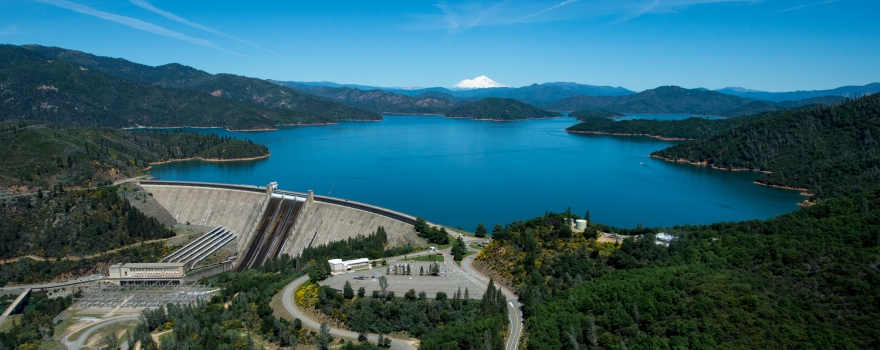From the Bureau of Reclamation:
The Bureau of Reclamation today announced the initial 2020 water supply allocation for Central Valley Project contractors. Allocation amounts are based on an estimate of water available for delivery to CVP water users and reflects current reservoir storages, precipitation, and snowpack in the Central Valley and Sierra Nevada.
“Today’s allocation comes on the heels of an operations plan signed last week, underscoring the Trump administration’s commitment to bringing a sustainable and reliable water supply to California’s Central Valley. While that operations plan is based on the best available science and maximizes water supplies, we still face significant uncertainty due to legal challenges,” said Reclamation Commissioner Brenda Burman. “Despite the hurdles brought on by litigation from the state and others, we remain committed to providing reliable water for families, farms, cities and the environment.”
California benefited from wet weather and significant snowpack in late 2019, but precipitation and snowpack have been below average so far in 2020. The California Department of Water Resources reports that as of February 24, statewide average snow water content in the Sierras was just 41% of the April 1 average. Current Northern Sierra precipitation is about 51% of the seasonal average.
“After a promising start to our precipitation season, January and February turned much drier than average,” said Reclamation’s California-Great Basin Regional Director Ernest Conant. “Fortunately, our project reservoirs are still hovering above average thanks to the wet winter last year, but with little precipitation in the forecasts, we must remain cautious with supplies and allocations this early in the year.”
Shasta Reservoir’s 4.5 million acre-feet capacity represents the majority of CVP water storage. Water from Shasta is used for many purposes, including contractor supply for north and south of the Sacramento-San Joaquin River Delta, as well as ensuring adequate temperatures can be maintained downstream of the dam throughout the summer and fall for threatened and endangered species. Currently, reservoir storage is above the historic average for this time of the year. However, runoff forecasts still predict that overall storage might be limited if typical spring precipitation does not materialize.
“While we’re constrained by the water nature provides, our new CVP operations plan will improve operations to maximize water supplies,” Conant said. “We recognize the importance of providing meaningful allocations early in the year, especially for our agricultural contractors’ planning needs.”
Given the low snowpack and low projected runoff this spring and summer, Reclamation is announcing the following initial allocations:
North-of-Delta Contractors (Including American River and In-Delta Contractors)
- Agricultural water service contractors North-of-Delta are allocated 50% of their contract supply.
- Pursuant to Reclamation’s M&I water shortage guidelines, M&I water service contractors North-of-Delta (including American River and In-Delta Contractors) are allocated 75% of their historic use or public health and safety needs.
- The Sacramento River Settlement Contractors are allocated 100% of their contract supply.
Eastside Water Service Contractors
- Eastside water service contractors (Central San Joaquin Water Conservation District and Stockton East Water District) will receive 100% of their contract total.
South-of-Delta Contractors
- Agricultural water service contractors South-of-Delta are allocated 15% of their contract supply.
- M&I water service contractors South-of-Delta are allocated the greater of 65% of their historic use or public health and safety needs.
- The San Joaquin River Exchange Contractors and San Joaquin Settlement Contractors are allocated 100% of their contract supply.
Wildlife Refuges
- Wildlife refuges (Level 2) North- and South-of-Delta, which also have allocations subject to pre-established Shasta inflow criteria, are allocated 100% of their contract supply of 422,000 acre-feet.
Friant Division
- Friant Division contractors’ water supply develops in the Upper San Joaquin River Basin Watershed and is delivered from Millerton Lake through Friant Dam to the Madera Canal and Friant-Kern Canal. The first 800,000 acre-feet of available water supply is considered Class 1; and Class 2 is considered the next amount of available water supply up to 1.4 million acre-feet. Given the current hydrologic conditions, Reclamation determined that Friant Class 1 initial allocation will be 20% and Class 2 will be 0%.
- For the San Joaquin River Restoration Program, Reclamation is currently forecasting a “Critical-High” water year type, providing for 70,919 acre-feet to be used for Restoration Program purposes.
In addition to the 2020 initial CVP water allocation, several South-of-Delta and Friant Division contractors are rescheduling unused water from 2019 supplies into 2020. That water is being stored in San Luis Reservoir and Millerton Lake. The option to reschedule (carry over) water in San Luis Reservoir and Millerton Lake from one contract year to the next has been available to the water service contractors since the early 1990’s. That carry over option was instituted after a series of dry years in the early 1990’s to encourage conservation and best water management practices.
Reclamation notified the Sacramento River Settlement Contractors, San Joaquin River Exchange Contractors, San Joaquin Settlement Contractors, and Refuge Contractors that the forecasted inflow to Shasta Lake is currently greater than 3.2 million acre-feet and we are not currently in a “Shasta Critical” year as that term is defined in their contracts.
As the water year progresses, changes in hydrology and opportunities to deliver additional water will influence future allocations. Water supply updates will be made as appropriate and posted at https://www.usbr.gov/mp/cvp-water/index.html.
For additional information, please contact the California-Great Basin public affairs office at 916-978-5100 (TTY 800-877-8339) or email mppublicaffairs@usbr.gov.
FOR MORE INFORMATION …
MEDIA CALL: Central Valley Project officials discuss water allocations



